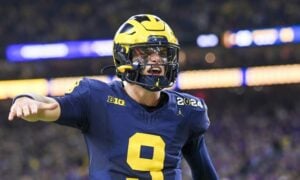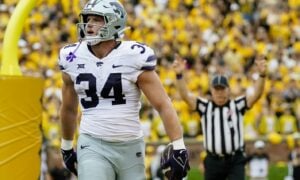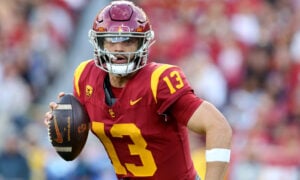DLF Live Draft Recap: Turning to Your Favor
[A quick note on the league format: it is a superflex league with 0.25 points per carry, 1.0 points per reception, and 1.5 points per reception for tight ends. You must start at least one QB, two RBs, two WRs, and one TE, plus the superflex and two other flex spots. Unlike typical WR-heavy dynasty leagues, no position has a strong advantage in this format.]
If you’ve never participated in a live draft, I would encourage you to do so. It really is more fun than it should be, and everyone needs to experience it at least once. For our particular arrangement, we added some stipulations that no one would use phones / computers / tablets to assist with their drafts, and also that no trades were allowed during the start up. The first stipulation was to make this unique compared to the dozens of online drafts most of us go through each year, and the second was to keep things moving along so we could focus on completing our draft live and in person. A final note is that the draft order was not determined and announced until approximately 15 minutes before the draft began. Unlike your typical dynasty start up draft, we had to react to our draft position and adjust strategies on the fly in order to (hopefully) achieve success against some very stiff competition.
Pre-Draft Strategy
Given the fact that scoring more or less balances out positional value, I had only one strategy in mind to begin with. Once we added the stipulations in, this strategy was reinforced in my mind. My goal, before I even knew my draft position, was to react to what was going on in the draft and take value only in the first four rounds. By react, I mean that my intent was to attempt to be contrarian in contrast to the field. At the conclusion of the first four rounds, my intent was to evaluate my team composition and re-formulate a strategy for the remainder of the draft. Essentially, the first four rounds would dictate whether I was a contender or punting, and furthermore those first four rounds would be dictated by what everyone else was doing.
Beginning the Draft
[am4show have=’g1;’ guest_error=’sub_message’ user_error=’sub_message’ ]
I ended up with the 12 slot. Typically I prefer the 6-8 slot in a 12 team league as it offers protection from runs, and I like the way those positions play out with my overall dynasty tiers in the first two rounds. This was a disappointment for me, but I am no stranger to picking on the turn and resolved to make the most of it. My goal when I pick on the turn is to make an impact on the overall draft as well as to properly evaluate when it is best to reach and when it is best to pick up value that is falling.
In the first round, nine WRs went before my pick at 1.12. Todd Gurley (1.05) and Rob Grownkowski (1.06) were the only non-WRs to be picked ahead of my pick. Given the superflex format including .25 PPC, I was surprised to see such a WR heavy draft. Keeping with my pre-draft strategy, I selected Cam Newton and Ezekiel Elliot at the turn. These were my number two and number three rated players overall in this format, so I was elated to grab them not only in accordance with my strategy, but at picks 12 and 13. I had to convince myself to stick with this plan, though, as starting Cam/Andrew Luck or Cam/Russell Wilson were both very tempting propositions. The Cam/Zeke turn also provided an impact on the draft that I desired to establish. There were a number of audible “ooo’s” that occurred after these picks were announced.
In the eternity that is the wait between the 2.01 pick and the 3.12 pick, 11 more WRs flew off of the board. Rather than reach for the WR21 at the 36th pick, I took my number four rated RB in Devonta Freeman, and since this is a superflex league I was moderately surprised to see Blake Bortles still around. Bortles was #37 on my board and I took him at #37, so I didn’t quite match my goal of grabbing whoever was falling; however, everyone that I had ranked above 37 on my board that was still available had a big asterisk next to their name for me. Rookies Laquon Treadwell and Corey Coleman are unproven. Jordy Nelson and Jordan Reed have injury question marks. Devante Parker hasn’t fully proven his health and sustained productivity to my satisfaction. Ben Roethlisberger is older than I would like to draft given that I began with Cam/Zeke. Bortles provided a combination of youth, demonstrated year over year growth, an ascending offense, and since this is a superflex, I could fill my superflex spot by round four. An added bonus is that this Freeman/Bortles turn provided some shock value and impact to the overall draft as I was one of the last remaining drafters without a WR, but I had solidified myself with one of the best QB and RB situations in the league early.
QB: Cam Newton, Blake Bortles
RB: Ezekiel Elliot, Devonta Freeman
WR:
TE:
Post Round Four Analysis
Keeping with my initial strategy, with round four complete I needed to evaluate my team and adjust my strategy accordingly. Since teams typically fill RB last in win-now teams and I also had filled my superflex starting position filled earlier than anyone else, I figured I needed to take the approach of drafting a contender, while maintaining as much youth as possible to keep myself from entering a full rebuild in the near future. Since my first four picks were in win-now positions as well as relatively youthful (27 is pretty young for a QB (Cam)), so far my window was a long one but also one that opens immediately.
Middle Rounds – Five through Eight
I don’t typically consider round five to begin the middle rounds, but since I was picking at 5.12 it sure felt that way. My usual strategy this off-season has been to load up on underrated receivers that I perceive to be studs to fill my starting requirements. Those guys have mostly been Randall Cobb, Doug Baldwin, and Michael Floyd. I was quickly reminded that the caliber of competition in this league would be higher than what I am used to, as they were all gone by the 5.12 pick when Baldwin and Floyd are usually both available far later. Kritikos sniped Michael Floyd, as I was 100% prepared to take him at 5.12, but he grabbed him at 5.11. This caused a quick lapse for me as I had to adjust quickly. No WR was worth grabbing to me at this point, so I took Greg Olsen, my number two rated tight end, and Jamaal Charles, who was one of the players I passed on at the round three to four turn in favor of more stable assets. Olsen provided a stack with Cam as well as a high floor/ceiling combination, especially in a TE premium league. I prefer him to the WR34 (which we were up to) in almost any format. Charles was the RB14, which feels about right to me. He seemed likely to score more points than any WR I could draft, and since my superflex and TE slots were already filled he fit with my win-now mindset with upside for elite production. Again, I strongly feel that this turn created a splash and impacted the overall draft as pretty much no one was expecting a team to start with zero WRs through six rounds.
At the round seven to eight turn, I began to face a serious dilemma. 39 WRs were drafted before my picks, and I had zero WRs on my team. I needed to pick up WRs that could slot into my starting lineup or else I would be failing to execute the win-now strategy I was attempting to adopt. Despite strength at QB, RB, and TE, weakness at WR is very glaring in a dynasty league regardless of format. The pickings are slim when your first WR selection comes at WR40. I opted for the combination of Devin Funchess and Michael Thomas. Julian Edelman and Eric Decker were the only other WRs that I considered here, but I passed on them due to age. This was a calculated risk that certainly might backfire. Funchess was efficient in the last part of 2015, and provided an unique opportunity to pull off the triple stack of Cam/Olsen/Funchess in addition to being a hedge bet against Kelvin Benjamin going forward. Thomas has a larger opportunity than many are giving him credit for, and combined with his pedigree I like his upside as my WR2. Both of these picks provide youth, size, and TD upside despite their risk. I’m willing to accept their risk entirely at the value of WR40 and WR41. This was another pair of picks that drew audible reactions as the upside and opportunity are both theoretically immense.
QB: Cam Newton, Blake Bortles
RB: Ezekiel Elliot, Devonta Freeman, Jamaal Charles
WR: Devin Funchess, Michael Thomas
TE: Greg Olsen
Middle-Late Rounds, Nine through Fourteen
My targets here were Derrick Henry, Stefon Diggs, DeMarco Murray, Duke Johnson, Latavius Murray, and Michael Crabtree. Literally all of them were gone, so I figured I needed to load up on starters, particularly at wide receiver. I ended up taking Marvin Jones and Phillip Dorsett. Jones provides massive opportunity in the vacuum that Calvin Johnson’s retirement created in Detroit, and Dorsett is being discussed for an increased role after Coby Fleener moved on from the Colts and they project to move to more three wide receiver sets. Additionally, Dorsett is an excellent hedge against TY Hilton in an offense that appears to still be ascending.
At the round 11-12 turn, I faced my second major dilemma of the draft. Should I take more WRs due to my weak core there, or take a stab at value and increasing the opportunity score for my last flex slot? I opted for the latter, selecting the Ravens running back combo of Justin Forsett and Kenneth Dixon. I’m on record extolling the potential of the Ravens backfield, and securing both the presumed starter and his presumed eventual replacement in one fell swoop at a turn provided the shock and impact value I was looking for with my strategy.
For the round 13-14 turn, I needed to dip back into the wide receiver pool to help solidify that position. Given the strength of every other position on my team, I felt that I needed to take what I consider a “shotgun” approach to WR – whereby I draft as many high upside plays as possible in the hopes that two to three of them hit. Kamar Aiken, Travis Benjamin, Torrey Smith, and Tavon Austin were my targets at this pick, but all were taken by the time I was on the clock. I opted for Jamison Crowder as Brian Malone had shown before his first publication that rookie wide receivers with 50+ receptions tended to have better careers than those that didn’t. I paired Crowder with Kenny Bell, as he is a personal favorite of mine due to my chest thumping of Jameis Winston. These picks should provide decent depth with upside for more, which is all I could ask for at this point in the draft.
QB: Cam Newton, Blake Bortles
RB: Ezekiel Elliot, Devonta Freeman, Jamaal Charles, Justin Forsett, Kenneth Dixon
WR: Devin Funchess, Michael Thomas, Marvin Jones, Phillip Dorsett, Jamison Crowder, Kenny Bell
TE: Greg Olsen
Late Rounds – Fifteen through Twenty-two
Going into the late rounds, I had two goals in mind. I wanted to fill out my roster with high upside picks keeping in accordance with my shotgun approach at wide receiver, and I wanted to focus on becoming an anti-fragile team. I accomplished the first by buying into the Packers and Steelers offenses at bargain prices with Jeff Janis and Darrius Heyward-Bey, who both provide immense athleticism with murky opportunity. I then took Richard Rodgers as my TE2 to further buy into the Packers offense while providing depth behind Greg Olsen on my team. Spencer Ware was my next pick, as I think he provides the best chance to be the bellcow for the Chiefs if Charles, who I own, were to go down. The Ware pick helped to make my team anti-fragile.
In my final four picks, I took players who may have legitimate opportunity and definitely have athletic upside. Chris Johnson, a hedge against David Johnson, was my first of these picks. Some beat writers say he has a shot to be the starter, and he performed well before injury last year. That’s enough for me at this price. Rueben Randle has athletic prowess and a decent production history, and additionally provides a hedge against Nelson Agholor, whom I am very low on. Cody Latimer and Cordarelle Patterson are both athletic wide receivers that have largely been forgotten but could provide a high upside should they turn their careers around. Coming into the NFL, both were acknowledged to be raw and needing polish. In the years that followed, no one gave them enough time to acquire the polish. At this price, I’m willing to take the risk in an attempt to obtain the reward of them morphing into legitimate NFL wide receivers.
QB: Cam Newton, Blake Bortles
RB: Ezekiel Elliot, Devonta Freeman, Jamaal Charles, Justin Forsett, Kenneth Dixon, Spencer Ware, Chris Johnson
WR: Devin Funchess, Michael Thomas, Marvin Jones, Phillip Dorsett, Jamison Crowder, Kenny Bell, Jeff Janis, Darrius Heyward-Bey, Rueben Randle, Cody Latimer, Cordarelle Patterson
TE: Greg Olsen, Richard Rodgers
Post Draft
My wide receiver corps is an obvious risk, but a calculated one that allowed me strength at every other starting position. In a superflex, TE Premium league, carrying only two quarterbacks and two tight ends is another obvious risk. I’m hoping to ride this strategy for 2016, but am prepared to sell off high upside youth for depth if it becomes necessary.
My anti-fragility at RB solidifies, in my mind, that I have the strongest RB corps in the league. Given the 1 PPR / .25 PPC scoring for RB in this league, I like my odds of this team excelling in 2016. While my projected starters at receiver may not be my ending starters there, I have a nice mix of youth, opportunity, and athletic upside in a good mix of offenses that should provide flexibility both with my starters and with future trades.
I aim to compete in 2016 at the expense of those extolling the virtues of the zero-RB strategy. If it becomes apparent my current lineup cannot accomplish this, Ezekiel Elliot should provide premium trade value for a wide receiver while my remaining running backs should still provide above average production.
[youtube id=”0Kz7NSqNLHE” align=”center” maxwidth=”1000″]
[/am4show]
- Sunday Morning Huddle: Week 15 - December 17, 2017
- Sunday Morning Huddle: Week 14 - December 10, 2017
- Sunday Morning Huddle: Week 13 - December 3, 2017


































































